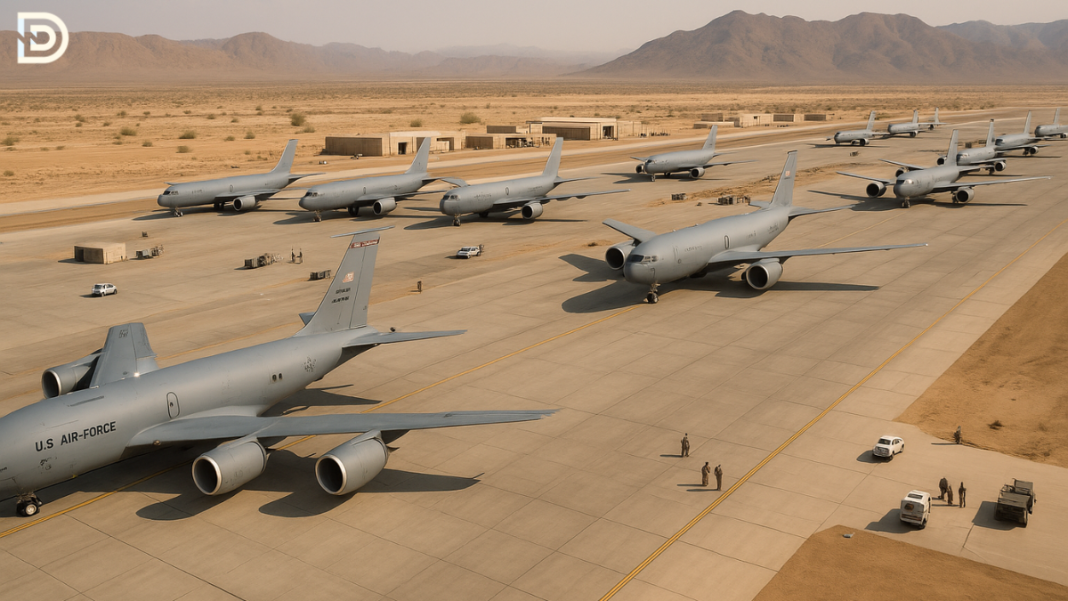The United States Air Force has recently made a very unusual and large move. Over 30 special aircraft called aerial tankers have flown from American bases across the Atlantic Ocean. These planes are not fighters or bombers—they are flying gas stations. They help other planes stay in the air longer by refuelling them mid-flight.
This sudden movement of so many tankers has caused people around the world to pay close attention. It is believed that these tankers might be heading to support military operations connected to the ongoing conflict between Israel and Iran. The tankers being sent are KC-135 and KC-46 models. These are designed to refuel jets in mid-air so that they can travel far without stopping to land.
In total, the number of these aircraft is still rising, but more than 30 were already reported to have crossed the Atlantic by the evening of June 15. Some of them might support Israeli planes during long missions, while others could help U.S. jets or bombers if the American military becomes more directly involved in the war.
Why Aerial Refuelling Is So Important in This Conflict
Most fighter jets need help if they want to fly long distances. Even though Israeli F-15s can reach targets deep inside Iran without help, most of Israel’s air force uses F-16s. These jets cannot go as far, even when they carry extra fuel tanks. If they are trying to hit targets far inside Iranian territory, they would likely need aerial refuelling.
That’s where tankers come in. These planes fly high above the ground and transfer fuel to the fighter jets through a long tube or hose. It’s like filling up a car while it’s still driving down the highway. Without this kind of help, many fighter jets would not be able to reach their targets and return safely.
The need for tankers is even greater for U.S. aircraft. American Navy jets that launch from aircraft carriers may have to stay far from the fight because of the danger from Iranian missiles. That means their planes need to fly extra-long distances, making in-air refuelling very important.
Western-made fighter planes generally have shorter flight ranges compared to jets made by China or Russia. For example, the American F-35 can only fly about 1,000 kilometers before needing to refuel. In comparison, the Chinese J-20 and the Russian Su-34 can go almost twice as far. So, to operate in far-off war zones like the Middle East, Western forces often rely heavily on tankers.
Growing U.S. Role in the Middle of a Dangerous Situation
The United States is already helping in the conflict. It has sent advanced missile defence systems, like THAAD, and powerful Navy ships equipped with AEGIS technology. These are being used to shoot down Iranian missiles aimed at Israeli cities and military sites.
Even though the U.S. is not officially fighting in the war with jets and bombs yet, its growing involvement shows how serious the situation has become. Sending dozens of tankers signals that the U.S. might be preparing for more direct action.
Iran’s missile systems are also something to be concerned about. The country has built up a large stockpile of long-range missiles. These can hit military bases far away—even across the Middle East and parts of Europe. What makes them dangerous is not just how far they can travel, but how accurate they are. Iran’s missiles have shown they can strike exact targets even in areas with strong air defences.
This makes any new involvement by the U.S. risky. If American forces get more deeply involved, they might face attacks not just in the war zone but across the region. Bases, ships, and even allies might come under fire.
As tankers continue to arrive and tensions rise, the world watches closely. The movement of these aircraft, usually kept in the background, is now at the centre of one of the most dangerous international crises in recent years.
